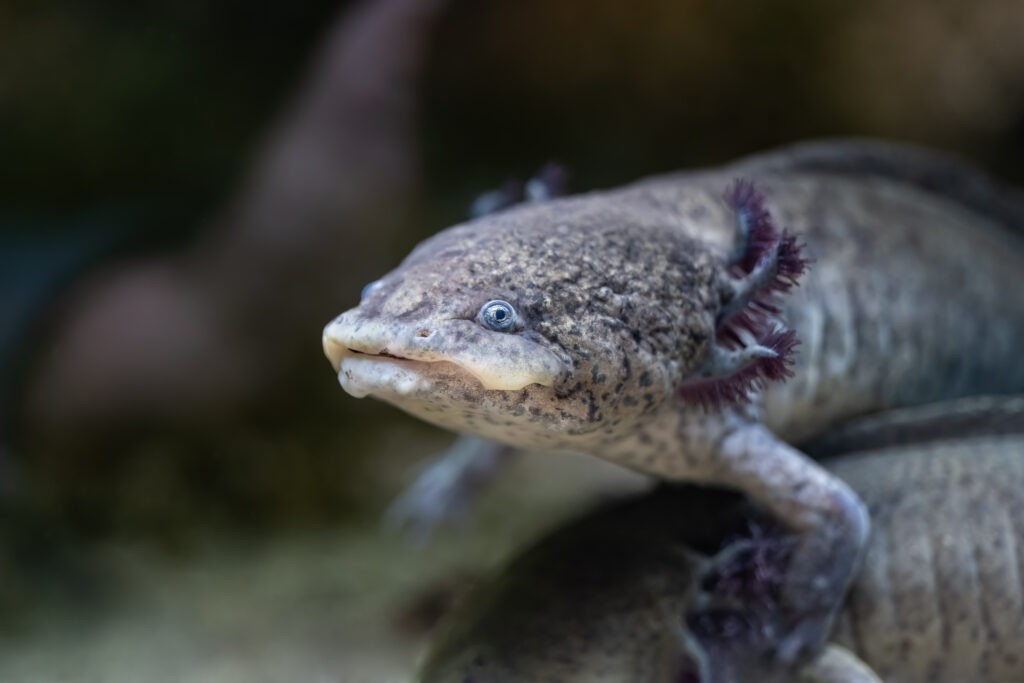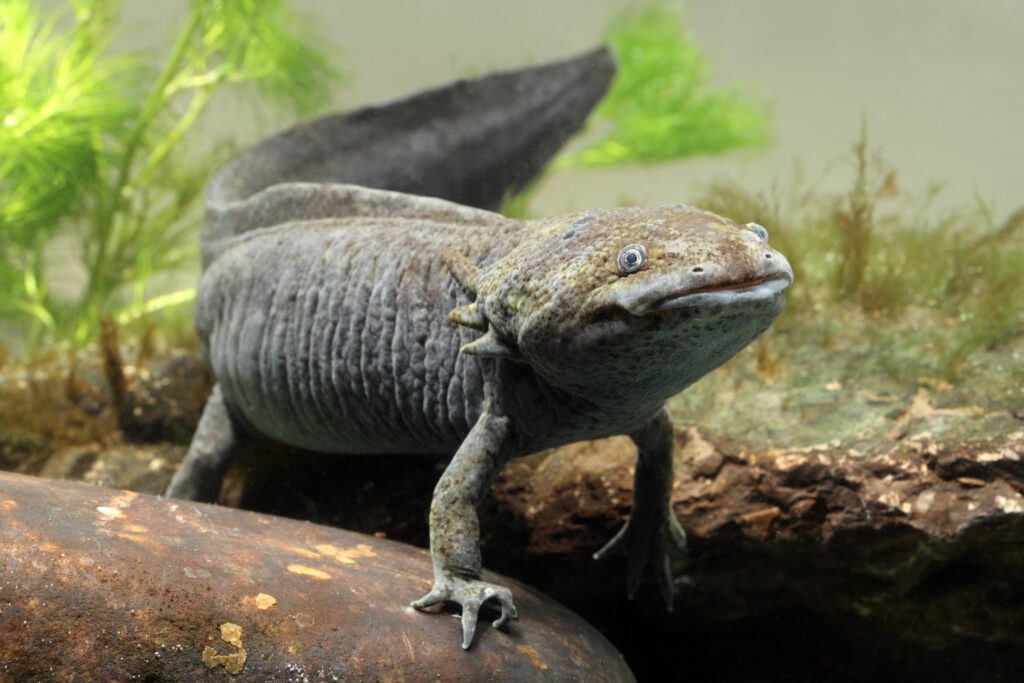Axolotls, those fascinating amphibians with their distinctive feathery gills, are facing a serious threat, and understanding Why Are Axolotls Endangered is crucial for their survival. This article from WHY.EDU.VN delves into the complex reasons behind their declining populations, exploring habitat loss, pollution, and other critical factors impacting these unique creatures. Learn about the conservation efforts needed to protect these remarkable animals and how their diminishing numbers could impact us all, influencing biodiversity and even regenerative medicine research. Discover more about axolotl conservation and the challenges of species preservation.
1. What is an Axolotl?
The axolotl (Ambystoma mexicanum), often called the “Mexican walking fish,” is a neotenic salamander belonging to the Ambystomatidae family. Its neoteny means it retains larval characteristics, such as external gills and a dorsal fin, throughout its adult life. Instead of undergoing metamorphosis like other salamanders, it remains aquatic, giving it a perpetually youthful appearance. This unique trait has made it a subject of scientific curiosity and a popular pet.
1. 1. Unique Characteristics of Axolotls
Axolotls possess several remarkable features:
- Neoteny: As mentioned, they retain their larval traits into adulthood.
- Regeneration: Axolotls can regenerate limbs, spinal cords, and even parts of their brains without scarring. This ability is of immense interest to medical researchers.
- Aquatic Lifestyle: Unlike many salamanders that transition to land, axolotls remain fully aquatic throughout their lives.
- Gills: They have three pairs of external gills, giving them a feathery appearance.
- Coloration: While commonly seen in white or pink in captivity, wild axolotls are typically darker, often brown or mottled.
1. 2. Axolotls and Mexican Culture
Axolotls have deep roots in Mexican culture, stemming from Aztec mythology. They are considered embodiments of the god Xolotl, who transformed himself into a salamander to avoid sacrifice. This mythical connection underscores the historical significance of axolotls in the region.
Sadly, this cultural reverence hasn’t translated into complete protection. Axolotls are sometimes viewed as a delicacy in Mexico City, contributing to overfishing and further endangering the species.
2. What Does an Axolotl Look Like?
Axolotls have distinct physical characteristics that set them apart. They typically range in length from 15 to 45 cm (6 to 18 inches) and weigh between 50 and 250 grams. Their bodies feature:
- Wide Heads: Giving them a somewhat comical expression.
- Short Limbs: Proportional to their body size.
- Feathery Gills: Usually three pairs, protruding from the sides of their heads.
- Webbed Feet: Aiding in swimming.
- Dorsal Fin: Running along the length of their body.
2. 1. Color Variations in Axolotls
Axolotls exhibit a variety of colors. In the wild, they are typically brown, grey, or mottled with gold or green. Captive-bred axolotls come in a wider range of colors, including:
- White: Often with pink gills.
- Golden Albino: A yellow or gold coloration.
- Melanoid: Dark brown or black.
- Leucistic: Pale with black eyes.
2. 2. Physical Adaptations for Aquatic Life
The axolotl’s physical traits are well-suited to its aquatic environment:
- Gills: Efficiently extract oxygen from the water.
- Webbed Feet: Enhance swimming ability.
- Flattened Tail: Acts as a rudder for maneuvering in the water.
- Lack of Eyelids: Adapted for underwater vision.
3. Where Do Axolotls Live?
Axolotls are native to only two freshwater lakes in Mexico: Lake Xochimilco and Lake Chalco, located in the southern part of Mexico City. Sadly, Lake Chalco was drained to prevent flooding, leaving Lake Xochimilco as their primary natural habitat. However, even Xochimilco faces numerous threats, making the axolotl’s survival precarious.
3. 1. Lake Xochimilco: The Axolotl’s Last Stand
Lake Xochimilco is a remnant of a vast lake system that once covered much of the Valley of Mexico. Today, it is a network of canals and artificial islands called chinampas, created for agriculture. While these chinampas provide a habitat for axolotls, they are also subject to pollution and other environmental pressures.
3. 2. Threats to the Axolotl’s Habitat
Several factors threaten the axolotl’s natural habitat:
- Pollution: Untreated sewage and agricultural runoff contaminate the water.
- Habitat Loss: Urban development encroaches on the lake and canal system.
- Invasive Species: Introduced fish compete with axolotls for food and prey on them.
- Water Extraction: Depletes the water levels, reducing the available habitat.
4. What Do Axolotls Eat?
Axolotls are carnivores, meaning their diet consists primarily of meat. In their natural habitat, they feed on:
- Worms: A common source of protein.
- Insects: Both aquatic and terrestrial insects that fall into the water.
- Crustaceans: Such as small shrimp and other invertebrates.
- Molluscs: Including snails and other small shellfish.
- Small Fish: Occasionally, they may prey on tiny fish species.
They use a suction-feeding technique to capture their prey, drawing water and food into their mouths. While they have teeth, these are not used for chewing but rather for gripping prey. Axolotls sometimes ingest gravel to help grind food in their stomachs.
4. 1. Diet in Captivity
In captivity, axolotls are typically fed:
- Bloodworms: A staple food.
- Blackworms: Another nutritious option.
- Daphnia: Small aquatic crustaceans.
- Axolotl Pellets: Commercially available food formulated for their needs.
4. 2. Threats to Food Sources
The axolotl’s food sources are also threatened by:
- Pollution: Contaminates and reduces the populations of their prey.
- Habitat Degradation: Destroys the habitats of the organisms they feed on.
- Invasive Species: Compete with axolotls for the same food sources.
5. Lifespan of an Axolotl
The average lifespan of an axolotl in the wild is around 5 to 6 years. However, in captivity, with proper care, they can live for 10-15 years, and sometimes even longer. Their lifespan is influenced by:
- Habitat Quality: Clean water and abundant food sources contribute to a longer life.
- Predation: In the wild, they are vulnerable to predators such as birds and larger fish.
- Disease: Susceptible to fungal and bacterial infections.
- Genetics: Some individuals may be predisposed to longer lifespans.
5. 1. Breeding Habits
Axolotls typically breed once a year, usually around February or March. The breeding process involves a courtship ritual where the male deposits spermatophores (packets of sperm) on the substrate. The female then picks up these spermatophores with her cloaca to fertilize her eggs internally.
Females can lay up to 1,000 eggs, which they attach to plants or other objects in the water. The eggs hatch after about two weeks, and the larvae are independent from the start, receiving no parental care.
5. 2. Regeneration and Longevity
The axolotl’s remarkable ability to regenerate limbs and other body parts may contribute to its longevity. By regenerating damaged tissues, they can recover from injuries and potentially live longer than other salamanders.
6. How Do Axolotls Differ From Other Salamander Species?
Axolotls differ significantly from other salamander species in several ways:
- Neoteny: As previously mentioned, their retention of larval characteristics is a key difference.
- Aquatic Lifestyle: Most salamanders undergo metamorphosis and live on land as adults, while axolotls remain aquatic.
- Habitat: Axolotls are native to a very limited area in Mexico, while other salamanders have a wider distribution.
- Size: Axolotls tend to be larger than many other salamander species.
6. 1. Comparison Table: Axolotl vs. Typical Salamander
| Feature | Axolotl | Typical Salamander |
|---|---|---|
| Metamorphosis | Absent (Neotenic) | Present (Usually) |
| Habitat | Freshwater Lakes in Mexico | Varies, Aquatic & Terrestrial |
| Adult Lifestyle | Fully Aquatic | Often Terrestrial |
| Size | Larger, up to 45 cm | Smaller, Varies |
| Distribution | Limited to Xochimilco | Wider Distribution |


6. 2. Evolutionary Significance
The axolotl’s unique characteristics make it an important species for evolutionary studies. Its neoteny and regenerative abilities provide insights into the genetic mechanisms that control development and tissue repair.
7. Are Axolotls Endangered?
Yes, axolotls are classified as critically endangered by the International Union for Conservation of Nature (IUCN). This means they face an extremely high risk of extinction in the wild. Their populations have declined dramatically in recent years, primarily due to:
- Habitat Loss: The draining of Lake Chalco and the degradation of Lake Xochimilco.
- Pollution: Contamination of the water with sewage, agricultural runoff, and industrial waste.
- Invasive Species: Predation and competition from introduced fish.
- Overfishing: Harvesting for food and the pet trade.
7. 1. Population Decline Statistics
According to studies by Mexican biologist Luis Zambrano, the axolotl population in Lake Xochimilco has plummeted:
- 1998: 6,000 axolotls per square kilometer
- 2003: 1,000 axolotls per square kilometer
- 2008: 100 axolotls per square kilometer
- 2014: 36 axolotls per square kilometer
These figures illustrate the severity of the axolotl’s decline and the urgent need for conservation efforts.
7. 2. IUCN Red List Status
The IUCN Red List assessment highlights the critical factors contributing to the axolotl’s endangered status:
- Habitat Degradation: Pollution and loss of habitat.
- Invasive Species: Introduction of non-native fish.
- Limited Range: Restricted to a small area in Mexico.
8. Why Are Declining Axolotl Populations Concerning?
The decline in axolotl populations is concerning for several reasons:
- Loss of Biodiversity: Axolotls are a unique and important part of the ecosystem in Lake Xochimilco. Their extinction would represent a significant loss of biodiversity.
- Scientific Value: Axolotls are valuable research animals due to their regenerative abilities. Their disappearance would hinder scientific progress in regenerative medicine.
- Cultural Significance: Axolotls have cultural significance in Mexico, and their loss would be a cultural tragedy.
- Ecosystem Imbalance: Their decline can disrupt the balance of the food web in their habitat.
8. 1. The Axolotl’s Regenerative Abilities
Axolotls possess an extraordinary ability to regenerate limbs, spinal cords, and even parts of their brains without scarring. This ability is of immense interest to scientists studying regenerative medicine. Understanding the mechanisms behind axolotl regeneration could lead to breakthroughs in treating human injuries and diseases.
8. 2. Impact on Medical Research
The axolotl’s regenerative abilities have the potential to revolutionize medical treatments:
- Limb Regeneration: Could lead to therapies for amputees.
- Spinal Cord Repair: Could help individuals with spinal cord injuries.
- Brain Repair: Could aid in the treatment of stroke and other brain injuries.
- Scar-Free Healing: Could improve wound healing and reduce scarring.
9. Factors Contributing to Axolotl Endangerment
Several factors contribute to the axolotl’s endangered status:
9. 1. Water Pollution
The rapid development of Mexico City has led to increased water pollution in Lake Xochimilco. Untreated sewage, agricultural runoff, and industrial waste contaminate the water, making it inhospitable for axolotls and their prey.
9. 2. Overfishing and the Pet Trade
Axolotls are sometimes harvested for food and the pet trade, further depleting their populations. Although trade in wild-caught axolotls is illegal, poaching still occurs.
9. 3. Habitat Loss
The draining of Lake Chalco and the ongoing degradation of Lake Xochimilco have reduced the axolotl’s available habitat. Urban development, agriculture, and other human activities continue to encroach on their habitat.
9. 4. Invasive Species
The introduction of non-native fish, such as tilapia and carp, has had a devastating impact on axolotl populations. These fish compete with axolotls for food and prey on them, further reducing their numbers.
10. Conservation Efforts
Several conservation efforts are underway to protect axolotls and their habitat:
10. 1. Habitat Restoration
Efforts are being made to restore and protect Lake Xochimilco:
- Water Treatment: Implementing wastewater treatment plants to reduce pollution.
- Canal Cleaning: Removing trash and debris from the canals.
- Chinampa Restoration: Supporting sustainable agriculture practices on the chinampas.
10. 2. Captive Breeding Programs
Captive breeding programs are being used to maintain axolotl populations and provide animals for research and conservation efforts. These programs aim to:
- Maintain Genetic Diversity: Prevent inbreeding and preserve the genetic diversity of axolotls.
- Reintroduction Programs: Potentially reintroduce axolotls into the wild.
- Research: Provide animals for scientific studies.
10. 3. Community Involvement
Engaging local communities in conservation efforts is crucial:
- Education: Raising awareness about the axolotl’s plight and the importance of conservation.
- Sustainable Livelihoods: Promoting sustainable tourism and other livelihoods that benefit the community and protect the environment.
- Community Monitoring: Involving local communities in monitoring axolotl populations and habitat quality.
11. What Can You Do To Help Axolotls?
You can contribute to axolotl conservation in several ways:
11. 1. Support Conservation Organizations
Donate to or volunteer with organizations that are working to protect axolotls and their habitat. Many organizations focus on:
- Habitat Restoration: Cleaning and restoring Lake Xochimilco.
- Education: Educating local communities and the public about axolotl conservation.
- Research: Conducting research on axolotl biology and conservation.
11. 2. Reduce Your Impact on the Environment
Reduce your impact on the environment by:
- Conserving Water: Using water wisely and reducing water pollution.
- Reducing Pollution: Avoiding the use of harmful chemicals and pesticides.
- Supporting Sustainable Products: Choosing products that are environmentally friendly.
11. 3. Advocate for Conservation
Advocate for policies that protect axolotls and their habitat. Contact your elected officials and express your support for conservation efforts.
12. The Future of Axolotls
The future of axolotls depends on the success of ongoing conservation efforts. By addressing the threats they face and working together to protect their habitat, we can help ensure that these remarkable creatures survive for generations to come.
12. 1. Hope for Recovery
Despite the challenges, there is hope for the recovery of axolotl populations. With continued conservation efforts and increased awareness, it is possible to reverse the decline and secure a future for these unique animals.
12. 2. The Importance of Continued Efforts
The axolotl’s story serves as a reminder of the importance of conservation and the need to protect endangered species and their habitats. By working together, we can make a difference and ensure that future generations have the opportunity to marvel at these incredible creatures.
FAQ: Understanding the Plight of the Axolotl
1. What is neoteny, and how does it affect axolotls?
Neoteny is a condition where an animal retains its larval characteristics into adulthood. In axolotls, this means they keep their gills, fins, and aquatic lifestyle instead of undergoing metamorphosis like other salamanders.
2. Where can axolotls be found in the wild?
Axolotls are native to Lake Xochimilco and formerly Lake Chalco in Mexico. Lake Chalco has been drained, making Lake Xochimilco their primary natural habitat.
3. What do axolotls eat in their natural habitat?
Axolotls are carnivores, feeding on worms, insects, crustaceans, mollusks, and small fish in their natural environment.
4. Why are axolotls considered critically endangered?
Axolotls are critically endangered due to habitat loss, pollution, invasive species, and overfishing, which have drastically reduced their population in recent years.
5. How does water pollution impact axolotl populations?
Water pollution from sewage, agricultural runoff, and industrial waste contaminates their habitat, making it uninhabitable and reducing the availability of their prey.
6. What role do invasive species play in the axolotl’s decline?
Invasive species like tilapia and carp compete with axolotls for food and prey on them, contributing to their population decline.
7. Why are axolotls important for scientific research?
Axolotls possess remarkable regenerative abilities, allowing them to regenerate limbs, spinal cords, and even parts of their brains without scarring. This makes them valuable for regenerative medicine research.
8. What conservation efforts are being implemented to protect axolotls?
Conservation efforts include habitat restoration, captive breeding programs, community involvement, and education to raise awareness about the importance of protecting axolotls and their habitat.
9. How can individuals help in the conservation of axolotls?
Individuals can support conservation organizations, reduce their environmental impact, advocate for conservation policies, and educate others about the plight of axolotls.
10. What is the current population trend for axolotls?
The axolotl population has drastically declined in recent years, with studies showing a significant decrease from thousands per square kilometer in the late 1990s to just a few dozen today.
The axolotl’s struggle for survival highlights the fragility of ecosystems and the impact of human activities on biodiversity. At WHY.EDU.VN, we are committed to providing comprehensive and reliable information to help you understand complex issues like species endangerment.
Do you have questions about endangered species or other environmental concerns? Visit WHY.EDU.VN at 101 Curiosity Lane, Answer Town, CA 90210, United States, or contact us via Whatsapp at +1 (213) 555-0101. Our experts are here to provide answers and insights. Don’t hesitate to reach out and deepen your understanding of the world around you! Explore the depths of knowledge with why.edu.vn and ask your questions today.
